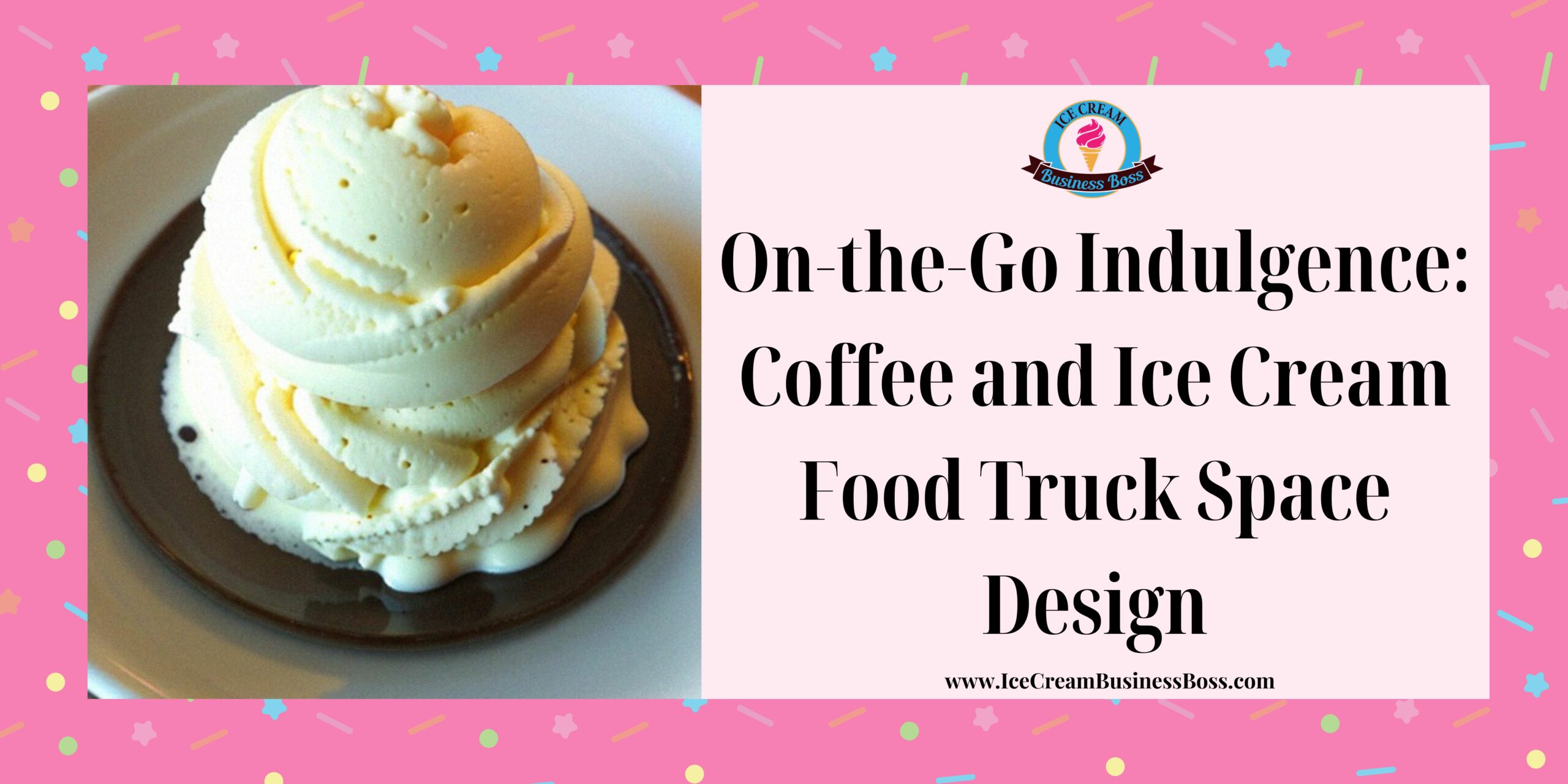The confluence of delightful flavors and the excitement of mobility has given rise to an original concept in the world of culinary entrepreneurship: coffee and ice cream food trucks. The olfactory attraction of freshly brewed coffee meets the tempting taste of ice cream in the confines of mobile gastronomic heaven in these rolling wonders. The trip from dream to reality, however, takes more than simply excellent recipes; it is dependent on a well-thought-out base – the floor layout.
To design coffee and ice cream food truck floor plans, you should combine functional kitchen space for equipment and prep, allocate service areas for customers, ensure efficient workflow, prioritize storage, and comply with health codes. Consider layout, dimensions, utilities, and seating arrangements.
This article delves into the art of designing floor plans for coffee and ice cream food trucks. Join us as we decipher the complexities of this gastronomic adventure, where creativity meets mobility to bring delight to the streets and smiles to the faces.
Functional Kitchen Space for Equipment and Prep
Every food truck’s kitchen, where culinary fantasies are realized, is at its center. The provision of sufficient space for equipment and preparation areas serves as a fundamental necessity in the context of designing a coffee and ice cream food truck. The design of this area is a complex ballet of efficiency and usefulness, where each component must work together to produce a setting that is favorable for the production of exquisite sweets.
The list of equipment for making coffee and ice cream reads like a symphony of flavors: coffee makers, espresso machines, blenders, and ice cream makers. The ensemble also includes storage facilities that hold a variety of materials and supplies. To ensure an ergonomic and effective workflow, each component of this kitchen orchestra requires meticulous attention during the design phase. Such factors are not just extras; they are the foundation upon which the entire culinary process is built.
The choreography that directs staff members’ dancing inside the food truck’s constraints is an ideal structure. The layout must be able to accommodate the busy movements of the culinary workers without obstructing or restricting them. The preparation procedure is kept as a well-orchestrated performance because of its fluidity, which boosts productivity and client satisfaction.
The design must show consideration for the air that the chefs breathe. To protect the sensory experience for clients as well as a comfortable working environment, adequate ventilation and exhaust systems are crucial. Freshly made coffee and just-churned ice cream should have a tantalizing aroma that doesn’t overrun the interior environment.
Service Area for Customers

Beyond the busy kitchen, a crucial component of the coffee and ice cream food truck experience is the development of a carefully planned service space. This area acts as a link between the culinary talent within and the diners’ anxious anticipation outdoors. The service area is more than just a place for transactions; it is a stage on which the dance of comfort and happiness takes place.
The order counter or window, which serves as a portal for clients to start their voyage of flavor discovery, sits at the center of this area. This counter’s layout requires careful attention because the effectiveness of order placement and staff-customer interactions directly depends on how well it functions. It is crucial to ensure a smooth process so that clients can communicate their needs and interact with the chefs who satisfy their cravings.
Another chance to give the food truck its distinctive style is in the serving area. When creating an environment that appeals to clients, aesthetic factors are crucial. The aesthetic appeal of the service area is enhanced by the thoughtful placement of eye-catching signage, artistically created menu boards and brand-consistent branding. These components combine to create a story that invites visitors to enter a world where delicious products and alluring aesthetics coexist.
Check out this article to learn more about creating a great floor plan for your ice cream shop.
Efficient Workflow
An effective workflow is the essential cornerstone of a thriving coffee and ice cream food truck. The lifeblood of the truck’s operations, this complex dance of movement and functionality makes sure that every order is filled quickly and at the highest standard. It takes painstaking attention to detail in the layout of the truck’s inside to create this unified dance.
The arrangement acts as a template for the complex movements of the staff, coordinating a symphony of preparation and service. It is a blank canvas on which each component has been carefully placed to reduce extra procedures and increase efficiency. The flow must be smooth and devoid of any obstacles that can disrupt the natural flow of activities from the preparation area, where materials are transformed into mouthwatering sweets, to the service counter, where client interactions conclude.
This design’s main goal is to avoid bottlenecks, those congested areas that might slow down service and reduce client satisfaction. These possible congested areas are anticipated and avoided by an ideal layout. This promotes a seamless and seamless experience for both the personnel and the clients.
Ensuring that commonly used tools and components are easily accessible is one of the important techniques to attain this efficiency. By keeping these necessities close at hand, staff members won’t have to make extra motions or circle the truck in search of tools or supplies. This ostensibly minor change may have a significant influence on service quality and speed, improving consumers’ overall satisfaction.
Prioritizing Storage Solutions
The importance of enough storage cannot be emphasized in the dynamic world of coffee and ice cream food trucks. A smooth performance of culinary perfection is orchestrated by orderly storage, which acts as the invisible conductor behind the scenes where the symphony of tastes takes shape. Every ingredient, from coffee beans to syrups, toppings to cones and cups, has its own assigned space within the truck’s limitations.
A well-organized storage system becomes the culinary artists’ most dependable ally as they create their masterpieces. The chaos of clutter is replaced by a sense of order and accessibility when each ingredient has a specific place. Everything being in its proper location makes the preparation process flow more easily, allowing the personnel to concentrate on their work rather than running around looking for supplies. This is where the beauty of reach lies.
Under-counter drawers, ceiling shelves, and carefully arranged nooks inside the truck’s interior all serve as strategic storage solutions. Utilizing the vertical space, overhead shelves keep objects visible and accessible without taking up valuable workplaces. Supplies are discretely stored in secret compartments beneath the counters, preserving the nearby area and facilitating quick mobility.
Effective storage has advantages that go beyond neat organizational design. They also value safety, fostering a setting where incidents brought on by objects falling or spilling are kept to a minimum. The risk of shifting during transit is reduced when products are stored properly, and the culinary treasures stay intact, preserving the caliber of both the journey and the finished result.
Compliance with Health Codes

The cornerstone of growth in the food industry is not simply good taste, but also a firm dedication to health and safety. This dedication is non-negotiable for food trucks; it forms the basis of every aspect of their business. Adhering to health and safety laws takes center stage as the canvas of a coffee and ice cream food truck comes to life, dictating the very blueprint that turns vision into reality.
Alignment with local health standards and regulations must be done before the ink on the final floor plan dries. These rules cover a wide range of factors, including the preciseness of hygiene procedures, the temperature at which food is stored, the complexity of waste disposal, and the effectiveness of ventilation systems. Each recommendation is a stitch in the tapestry of a healthy and safe food experience.
Collaboration with health authorities early on in the design process is essential. Early consultation with these professionals makes sure that the floor plan is created to not just adhere to but also beyond the requirements outlined by legislation. This proactive strategy protects against unpleasant surprises and potentially expensive changes in the future.
By working together with health authorities, the inspection process is streamlined and goes from being a difficult obstacle to a smooth transition. With a design based on compliance, the inspection transforms into a celebration of effort and dedication, a seal of approval for the dedication to protecting both the staff and consumers’ health.
Check out this article here to learn more ways to create ice cream parlor floor plan.
Layout, Dimensions, and Utilities
A coffee and ice cream food truck floor plan design is an art that requires a careful balance between form and function. A great layout creates a space where culinary ideas can flourish and client interactions can be enjoyable by smoothly fusing visual appeal with operational efficiency.
The positioning of the equipment, counters, and customer service areas becomes a crucial issue as the design’s components come together. The rhythm of preparation, service, and interaction are woven together pleasingly by this orchestration. The smooth transition from order to fulfillment is made possible by thoughtful arrangement, and the visual appeal of the space is maintained.
This dance is significantly influenced by the size of the food truck space. Each inch must be wisely used, converting constraints into chances for innovation. The ideal distance between workstations and consumer spaces contributes to the comfort of both employees and customers. It enables both the artists to do their craft with accuracy and the clients to enjoy their sweets comfortably.
The integration of necessary utilities completes the ensemble in addition to the spatial layouts. The equipment for making coffee and ice cream is fueled by water, electricity, and propane, which creates enticing brews and decadent scoops that fascinate the senses. These services widen their reach to include lighting and other crucial tasks, guaranteeing that the culinary performance is both physically and figuratively illuminated.
Seating Arrangements

The consideration of seating configurations within a coffee and ice cream food truck adds a diversity that goes beyond mere convenience in recognition of the varied desires of customers. While the attractiveness of grab-and-go service is still evident, certain consumers who prefer unhurried experiences find it appealing to linger and savor on-site.
It takes careful planning that complements the overall design to include seating inside the confines of the food truck. The available space serves as a blank canvas for creativity, providing the opportunity to design a setting that entices customers to enjoy their sweets slowly. Stools, benches, or even a small standing bar are options that would fit the truck’s layout and proportions.
The seating area’s placement must be carefully considered. It must smoothly fit into the truck’s overall design to prevent any impediments to effective service delivery. Customers can enjoy their coffee and ice cream without interfering with the flow of the culinary experience thanks to the harmony between utility and atmosphere.
The seating space is intended to improve the overall experience, not merely to serve as a place to rest. It changes the food truck from a pit stop to a destination, enabling customers to interact with both the delicious options and the alluring ambiance inside. Customers’ surroundings gradually take on the role of a backdrop to their delight, bringing a sense of calm to their interactions.
Frequently Asked Questions
How important is an effective workflow in the design of a coffee and ice cream food truck?
A well-designed workflow in a food truck is essential for seamless operations and rapid client service. It entails planning the arrangement of the kitchen, preparation rooms, and service counter in such a way that staff mobility is minimized, waiting times are reduced, and available space is maximized. An ordered workflow leads to faster order fulfillment, more staff efficiency, and a better overall customer experience.
How can I confirm that my coffee and ice cream food truck floor plan complies with health codes?
Ensuring compliance with health laws is critical for running a safe and sanitary food truck. To accomplish this, investigate and comprehend the local health regulations that relate to food service enterprises. Include features that comply with these requirements, such as sufficient ventilation, food storage solutions, waste disposal systems, and hygiene procedures. Engaging with local health authorities during the design phase can assist you in addressing any issues and making the required changes to satisfy the criteria.
What factors influence seating configurations in a coffee and ice cream food truck?
Customers can enjoy their sweets on-site thanks to seating arrangements in a coffee and ice cream food truck. While many customers prefer grab-and-go service, providing seating may entice others who wish to sit and enjoy their coffee or ice cream. Well-planned seating areas contribute to a comfortable and appealing environment, enabling guests to spend more time at your food truck. However, chairs should be strategically placed to avoid impeding the flow of customers and workers within the food truck’s restricted space.
The information provided by IceCreamBusinessBoss.com (“The Site”) is for general informational purposes only. All information on the Site is provided in good faith, however, we make no representation or warranty of any kind, express or implied, regarding the accuracy, adequacy, validity, reliability, availability, or completeness of any information on the Site. Under no circumstance shall we have any liability to you for any loss or damage of any kind incurred as a result of the use of the Site or Reliance on any information provided on the Site. Your use of the Site and your reliance on any information on the Site is solely at your own risk. This blog post is for educational purposes only and does not constitute legal advice. Please consult a legal expert to address your specific needs. Terms and Conditions.

Hi! I am Shawn and I am a happy individual who happens to be an entrepreneur. I have owned several types of businesses in my life from a coffee shop to an import and export business to an online review business plus a few more and now I create online ice cream/gelato business resources for those interested in starting new ventures. It’s demanding work but I love it. I do it for those passionate about their business and their goals. That’s why when I meet a ice cream/gelato business owner, I see myself. I know how hard the struggle is to retain clients, find good employees and keep the business growing all while trying to stay competitive.
That’s why I created Ice Cream Business Boss: I want to help ice cream and gelato business owners like you build a thriving business that brings you endless joy and supports your ideal lifestyle.

